ASEAN countries being next to mainland China were the first ones to come in contact with the Coronavirus. In fact, the first confirmed case outside China was detected in Thailand on 13 January who was a Chinese woman traveller from Wuhan and it was sometime afterwards that Chinese government officially announced spread of this virus in its city of Wuhan capital of Hubei province. ASEAN countries, by and far were quick to take remedial measures for checking the spread of this deadly disease. As a regional organization ASEAN also stepped in to work for a joint and coordinated response in meeting the challenges posed by Covid-19. ASEAN not only raised the awareness levels of its member countries but also liaised with international organizations and other countries to respond at multiple levels for addressing the problems posed by the new virus.
Vietnam as a Chair of ASEAN for the current year led the efforts of the ASEAN countries in forging a response to the outbreak of Covid-19 disease. It was as early as 15 February this year when the ASEAN Chairman’s Statement on ASEAN Collective Response to the Outbreak of Coronavirus Disease 2019 was issued. The statement expressed deep concerns over the spread of Covid-19, and recognized it as a “public health emergency of international concern”, as declared by the World Health Organisation (WHO).1 The ASEAN statement also emphasized upon its support for Chinese people and the Government of China as also for all countries around the world, in their tremendous efforts to deal with the outbreak of the COVID-19.2 Moreover, ASEAN countries led the humanitarian efforts in providing masks and medical supplies to China in the initial period of outbreak.
As part of its cohesive response to Covid-19 the ASEAN organized multiple meetings and conferences in the areas of health, economic and security areas. For instance a conference of ASEAN Defence Ministers on ‘Defence Cooperation against Disease Outbreaks’ was organized on 19 February 2020; ASEAN Economic Ministers (AEM) meeting was held 10 March 2020 for strengthening ASEAN's Economic Resilience in Response to the Outbreak of COVID-19 and ASEAN Health Ministers had a video conference on 7 April for Enhancing Cooperation on COVID-19 Response. These efforts were supplemented by ASEAN Plus Three format (ASEAN plus China, Japan and South Korea) wherein an ASEAN Plus Three Health (APT) Ministers held a conference for enhancing Cooperation on COVID-19 and APT Economic Ministers’ meeting on ‘Mitigating the Economic Impact of the COVID-19 Pandemic’ was held in June 2020.
It also needs to be noted that at the meeting ASEAN stressed the need for collective action to mitigate the economic impact of Covid-19 by adopting and leveraging technology-enabled measures. For instance, the AEM statement called for “leverage on technologies and digital trade to allow businesses, especially the micro, small and medium enterprises (MSMEs) to continue operations amidst the COVID-19 outbreak”.3 The statement also laid emphasis on making the trade facilitation platforms like ASEAN Single Window more robust so as to keep the supply chain activities ongoing.4
Later, on 14 April 2020, a Special APT Summit on Coronavirus Disease 2019 was held virtually. With Vietnam being the ASEAN Chair, this summit was chaired by Vietnamese Prime Minister Nguyen Xuan Phuc. 4 The joint statement resolved to strengthen the early warning system in the region for pandemic control, and for taking pre-emptive measures to boost market confidence in the region and to improve economic resilience.5 It was also agreed to establish a COVID-19 ASEAN Response Fund for public health emergencies. This was something like what India had proposed during the South Asian Association for Regional Cooperation (SAARC) virtual meeting held in March 2020 where PM Modi had suggested that a Covid-19 emergency fund be established to fight the pandemic6.
Thus through pro-active and concerted efforts, the ASEAN countries have enhanced their regional preparedness and adopted suitable mitigation strategies to tackle Covid19 outbreak. 7 In addition the ASEAN+3 Field Epidemiology Training Network has been engaged in experience sharing of national responses and thus building capacities and preparedness on a regional level.8
It was not only the regional efforts but also at individual nations’ levels that most of the ASEAN countries have been able to achieve a greater degree of success in dealing with the onslaught of the pandemic. In January Brunei and Singapore had started taking pro-active measures to fight Covid-19 and later in February many other South East Asian nations joined in. Indonesia’s National Board for Disaster Management declared state of emergency for one month on 29 January which was later extended. By the third week March most of ASEAN countries including Indonesia, Malaysia and Thailand were either in full or partial lockdown.
Brunei had commenced restricting travel from China in January to the utter discomfort of China and later in February restriction on entry to ports was also placed. The first case of Covid-19 however, occurred on 09 March and stiff fines were imposed on individuals violating the lockdown rules. Vietnam was the other country that had cancelled all flights from China, Hong Kong, and Macau from 01 February despite China’s resentment.
In fact Vietnam has been internationally recognized as a success story in its fight against the pandemic. PM Ngyuyen Xuan Phuc termed the fight against Covid-19 as the “Spring General Offensive of 2020,” alluding to the final offensive of North Vietnam against Saigon in 1975. Vietnam had speeded up testing soon after three people infected with the virus had returned from Wuhan in the last week of January. Vietnam has also taken steps to stop the illegal trade in wild life that has given rise to a number of virus related diseases9. The fact there have been no deaths in Vietnam and the number of confirmed cases as on 26 July 2020 have been 418 reflects positively on Vietnam’s endeavour in fighting the virus. A table depicting the country wise status of Covid-19 infections and fatalities is given below.
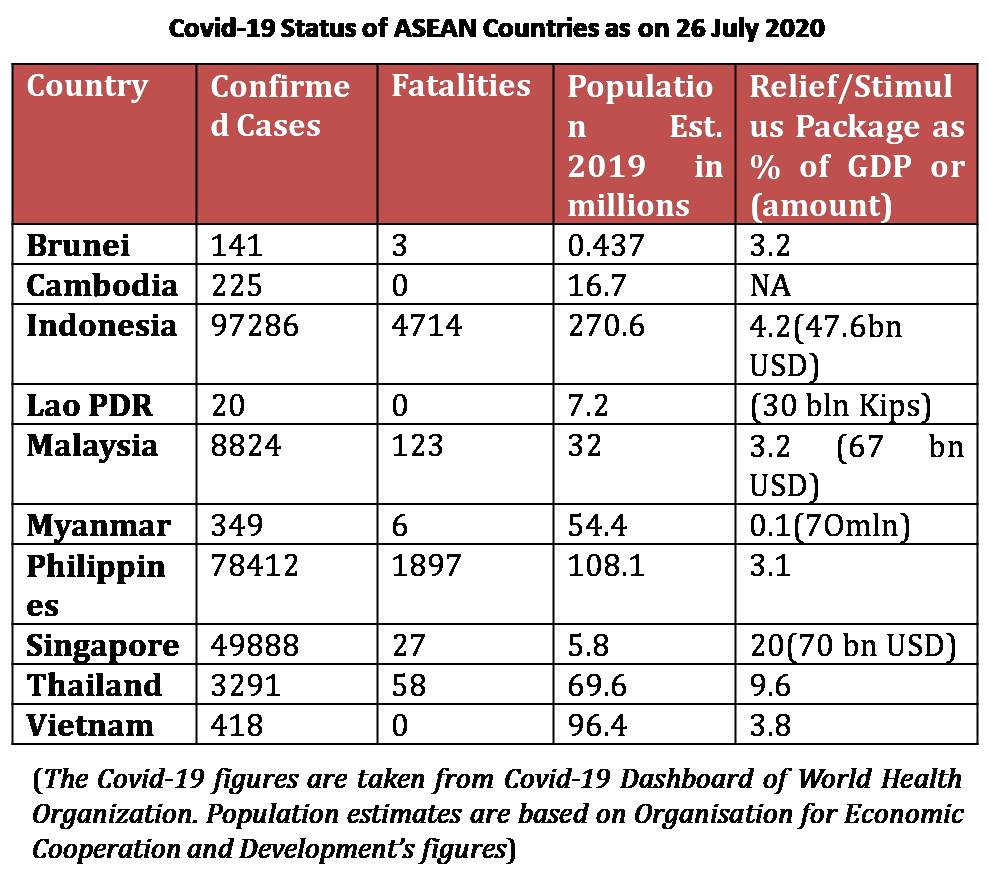
Cambodia and Laos also claim having no deaths and insignificant number of infections while Myanmar with six deaths and a very low number of infections remains largely free from coronavirus. However, one could speculate that not enough testing might have been done. Indonesia and Philippines have been severely affected by the pandemic but looking at the confirmed cases and deaths as a proportion of the population the intensity of spread of Covid-19 has so far been moderate. However, the potential for further spread of this disease remains high. Singapore with its good health care infrastructure even with its high number of cases has been able to restrict fatalities to a very low number. As can be noted from the Table above Singapore has a high number of Coronavirus cases due to high density of population despite its population being around 5.8 million. In a similar manner Thailand has also been able to control the incidence of Covid-19 as the numbers given in the Table reflect.
The ASEAN countries have largely been adept in executing appropriate Covid-19 mitigating strategies which also include providing economic stimulus packages and relief to their industries and people. Though comparatively economically better off countries like Singapore, Brunei and Malaysia and for that matter even Thailand have been able to provide a larger percentage of their GDP for supporting their health and economic infrastructures. On the health front Brunei, Indonesia, Malaysia, Myanmar, Philippines and Thailand have joined Covid-19 ‘Solidarity Trials’ an initiative of the World Health Organization (WHO) to find a cure for the virus.
Undoubtedly, in line with the negative impact of Covid-19 on economic growth worldwide the ASEAN countries’ economic growth would also be adversely affected. The Table below gives ASEAN economic outlook for the current year and projections for the next year.
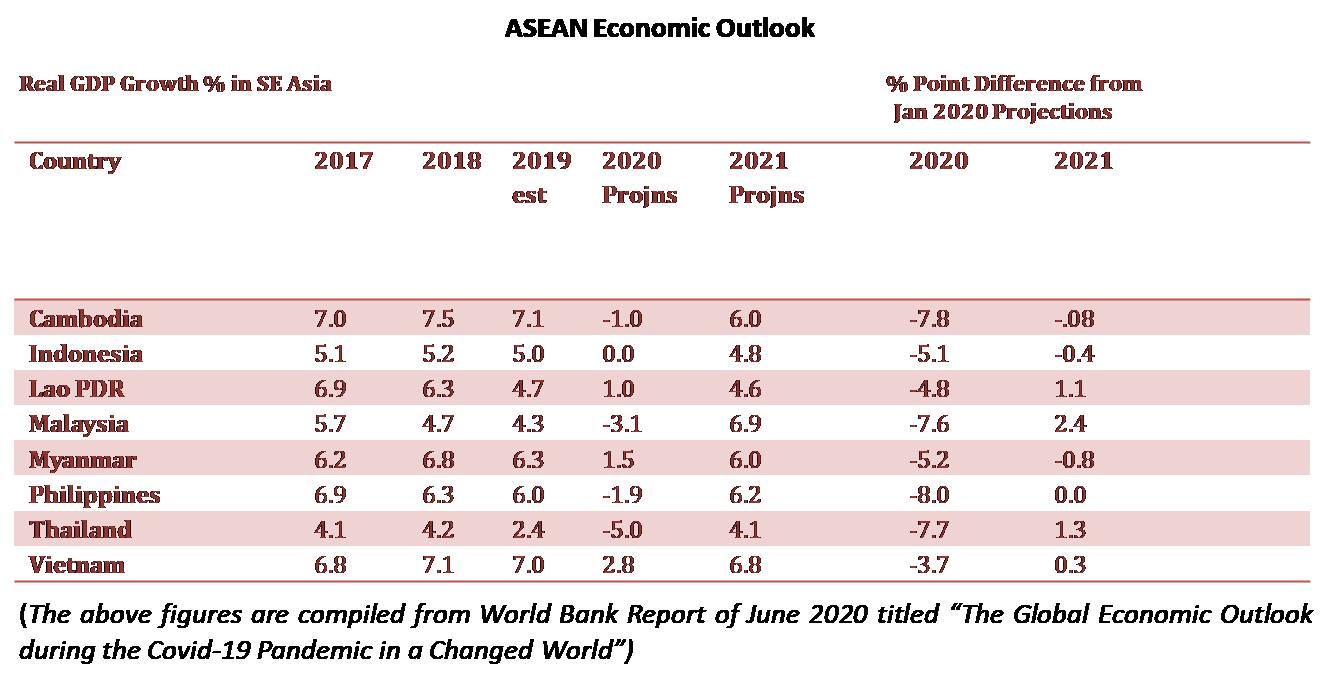 10
10
A comparative study of the growth figures shown above depict a contraction of economies in the current year followed by a recovery in the next year. Overall the World Bank Report forecasts 5.8 percent contraction in the global economy in the year 2020. ASEAN countries’ forecast is generally in line with this trend to a greater or lesser degree. However, some of the faster growing economies of ASEAN like Vietnam and Myanmar are still expected to show a positive rate of growth in the current year.
Therefore, ASEAN at the regional level has relatively done better in coordinating a joint response to Covid-19 as also in liaising with dialogue partners and international organizations when compared with regions like the European Union or for that matter countries like America, Brazil, Russia and many others. But the risk of Covid-19’s further spread has not gone away. Indonesia and Philippines are still vulnerable to an increase in the rate of growth of this affliction. The possibilities of second wave of Covid-19 in some of the ASEAN countries cannot be ruled out either. While there are lessons for other countries including India in the way ASEAN countries have handled Covid-19 the Covid-19 mitigating strategies would also need to be tempered by the local conditions and circumstances.
End Notes
- Chairman’s Statement On ASEAN Collective Response To The Outbreak Of Coronavirus Disease 2019, Available: https://asean.org/storage/2020/02/ASEAN-Chairmans-Statement-on-COVID-19-FINAL.pdf
- Ibid.
- Strengthening ASEAN’s Economic Resilience In Response To The Outbreak Of The Coronavirus Disease (Covid-19), 26th AEM Retreat, Available: https://asean.org/storage/2020/03/AEMR-26-Statement-on-COVID-19-FINAL-10.03.2020.docx.pdf
- Ibid.
- Joint Statement of the Special ASEAN Plus Three Summit on Coronavirus Disease 2019 (COVID-19), 14 April 2020, Available: https://asean.org/storage/2020/04/Final-Joint-Statement-of-the-Special-APT-Summit-on-COVID-19.pdf
- Ibid.
- Dipranjan Roy Chowdhury, “PM Modi Proposes Emergency Covid-19 Fund for Saarc Nations”, The Economic Times, 16 March 2020 available at https://economictimes.indiatimes.com/news/politics-and-nation/prepare-put-dont-panic-is-indias-mantra-to-counter-coronavirus-narendra-modi/articleshow/74638006.cms?from=mdr
- COVID-19 crisis response in ASEAN Member States, OECD, http://www.oecd.org/coronavirus/policy-responses/covid-19-crisis-response-in-asean-member-states-02f828a2/
- ASEAN, China, Japan, Korea epidemiology experts share disease surveillance experiences on COVID-19, 1 June 2020, Available: https://asean.org/asean-china-japan-korea-epidemiology-experts-share-disease-surveillance-experiences-covid-19/#
- Tawn Fawnthrope, “Can Vietnam Prevent the Next Pandemic”, The Diplomat, 28 July 2020 available at https://thediplomat.com/2020/07/can-vietnam-prevent-the-next-pandemic/
(The paper is the author’s individual scholastic articulation. The author certifies that the article/paper is original in content, unpublished and it has not been submitted for publication/web upload elsewhere, and that the facts and figures quoted are duly referenced, as needed, and are believed to be correct). (The paper does not necessarily represent the organisational stance... More >>
Image Source: http://www.asia-pacific.unsouthsouth.org/wp-content/uploads/2020/05/ASEAN-response-to-COVID-19-600x400.png

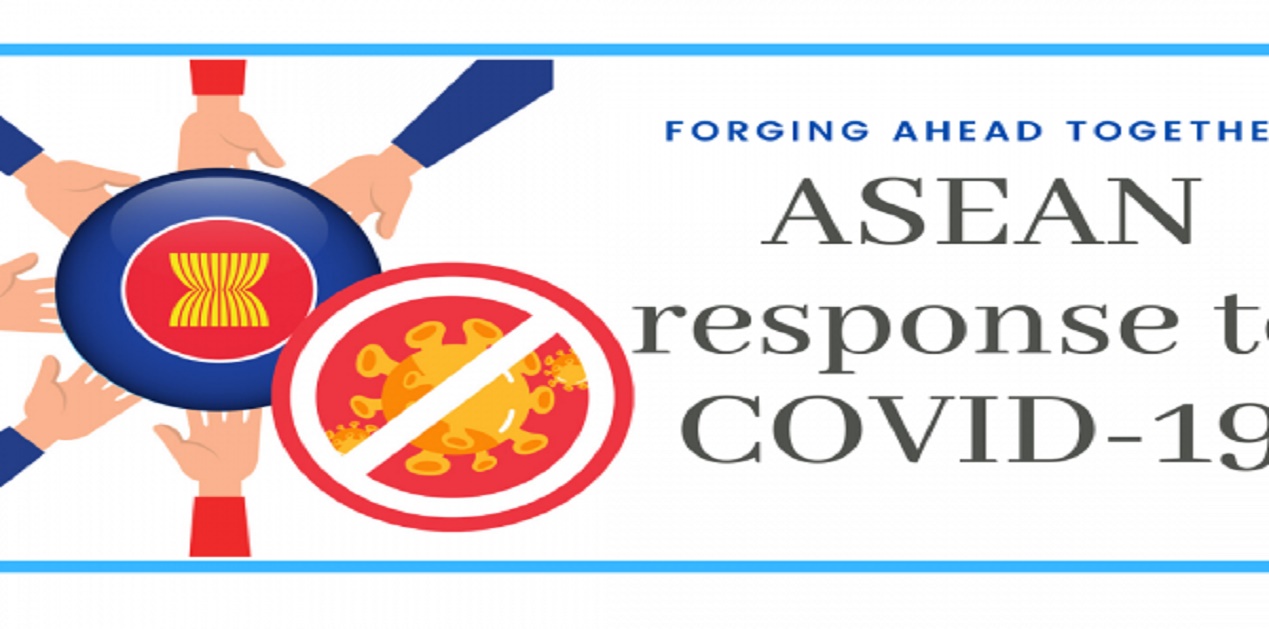


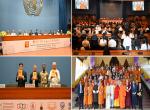
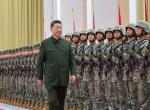



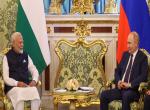

Post new comment